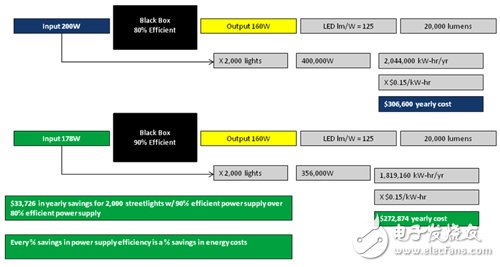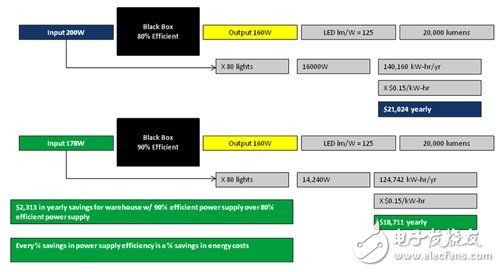Adding smart functions to light-emitting diode (LED) lighting applications requires replacing fixed-function LED drivers with microcontrollers (MCUs) or programmable architectures. For applications that require advanced functions, MCU can achieve many smart functions, such as NaTIve Dimming Control, Specialized Color Mixing, Adaptive Lighting Control (AdapTIve LighTIng Control), and Remote Link (Remote ConnecTIvity).
For lighting applications, MCUs dedicated to Power Electronics products can even effectively control the power supply of lamps, make them cost-effective, and perform lighting control and communication. Like the trend of many modern electronic products, the switch to digital control has opened up more flexible spaces and brought a new level of smart functions and differences to lighting products.
Dedicated MCU meets LED application market
After the rapid evolution of the lighting industry, today's LED technology shows many benefits. However, different types of LED lighting applications have great differences due to different supported functions. Among them, residential applications include bulb replacement, accent lighting (Accent Lighting) and small-scale outdoor lighting. Generally speaking, only one or two LED light strings need to be lit, but this market has cost pressures, so advanced control Not yet common. As for commercial applications, including fluorescent ballasts (Fluorescent Ballast), bulb replacement, and key lighting, only one or two LED light strings need to be lit, which is also limited by cost considerations. This market has a high energy-saving awareness; and High-end applications require remote connection and intelligent controller functions.
In addition, entertainment applications include high-end displays and mood lighting. Complete intensity control and consistent color quality are very important. For industry-standard communication protocols such as Digital Addressable Lighting Interface (DALI) or DMX-512, remote connection and support are also very important. Outdoors and infrastructure include street lighting, factory and office building lighting, etc. The equipment in this market generally has a large number of LEDs and must support many light strings. Among them, high-brightness LEDs are also quite common, and these applications are quite Requires remote connection and highly intelligent controller.
Reduce system construction cost MCU to achieve highly flexible LED lighting
The simplest LED lighting system uses LED drivers. These fixed-function devices can directly control the LED, and the cost is quite low. Generally speaking, these devices can achieve good energy efficiency and do not require software programming. In the worst case, the developer must perform multiple calculations, select the required driver, or determine the configuration values ​​of the circuit board components.
Although the LED driver can be used directly, it is not flexible enough for more advanced systems. To support different types of LEDs (such as high wattage or different colors), or different LED string configurations, different solutions may be required. In fact, any change in the system (such as the number of LEDs and the number of light strings) may cause the driver to change accordingly. Therefore, most lighting products supplied by the original equipment manufacturers (OEMs) may require unique analog drivers. For large series of products, this will increase the number of OEM or supplier inventory items, which may result in reduced economic scale or increased equipment costs.
On the other hand, smart controllers allow developers to build more flexible lighting systems. In the MCU system, the programming code can be set to support various LEDs, unique power level requirements, different light string lengths, and different numbers of light strings without having to significantly change the hardware. The system can also be designed to automatically detect which LEDs need to be driven. The programmable features of the MCU system can also achieve advanced dimming and sequencing functions, providing more advanced lighting scene control and automated lighting brightness.
Flexible digital control allows OEMs to design a single controller that can control multiple products. Because the controller IP can be reused, it can also greatly reduce design investment; the flexible controller can also reduce the number of devices in inventory, and at the same time reduce the overall system cost through greater economies of scale.
Contribute to the integration of intelligent LED lighting digital control
The basic architecture of an intelligent LED lighting system consists of three main stages, namely power conversion, LED control and communication (Figure 1). The power conversion stage will deliver the correct voltage and current to the LED. First, the AC-DC rectification, then the power factor correction (PFC) phase, and finally one or more parallel DC-DC (DC-DC) conversion phases. To provide effective power conversion, it is necessary to control these conversion stages accurately and flexibly.

Figure 1 Intelligent LED lighting system includes three main stages of power conversion, LED control and communication
Every major stage requires an intelligent controller to maintain efficiency and function. When using fixed-function analogies, individual PFC, DC-DC, LED, and communication controllers may be required. However, when using dedicated power electronics MCUs, the cost of components for lamp power supply can be reduced through a high degree of integration. With sufficient peripherals and communication ports optimized for efficiency and power, a single MCU can control the potential of the three major components of the lighting system power level, LED lighting control and communication. Through the digital integration function of the MCU, the lighting system can reduce many unnecessary components, while using a central programmable platform to coordinate and control the three main stages of the intelligent lighting system.
Digital power control can also improve the conversion efficiency of dynamic systems. Although the efficiency of LEDs is higher than that of traditional lighting equipment, the operation and energy costs are relatively reduced, but not all LED systems are identical. When dimming, changing the color output or adjusting the brightness output in any way, digital power control can make the power level of the LED lighting system achieve higher efficiency. Also in the case of fixed lighting, the MCU can also improve operational performance through more advanced power stage design. This increase in efficiency is quite attractive to the end user, and it is worth highlighting the difference for two LED systems that are otherwise identical.
For example, suppose a city plans to replace two thousand street lights. When comparing the two models, the efficiency reaches a 10% difference (Figure 2). It is worth noting that the system input power for high-efficiency systems is 178 watts (W), while low-efficiency systems require 200 watts to achieve the same 160-watt lighting output. This is equivalent to a 10% annual energy cost savings. The energy efficiency calculation of the power supply alone is equivalent to a savings of $ 33,726, which is much higher than the cost savings of LED systems.

Figure 2 The digital control of the power supply can achieve higher conversion efficiency than the analog system, and the cost savings are higher than LED technology. In this example, a 10% difference in efficiency is equivalent to a 10% annual energy cost savings. Calculating the energy efficiency of the power supply alone is equivalent to a savings of $ 33,726. This efficiency is quite attractive to end users, and it is a key difference for two LED systems that are the same in other parts.
Flexible correction of color and brightness MCU to improve the quality of LED lighting
For many applications such as commercial lighting and entertainment lighting, lighting quality is very important. Quality here refers to the ability to output consistent brightness and color. However, three major factors, manufacturing variation, temperature and aging, affect LED performance.
In addition, the LED output of each batch may vary greatly. Using the same batch of LEDs can maintain the quality of a single device stable. However, if devices of the same product line use different batches of LEDs, different lighting qualities may occur due to manufacturing variations. If two of the devices are installed next to each other, there may be significant differences and unacceptable lighting quality. Through the intelligent MCU, the system can be adjusted to make up for any differences. Since this is done with software, when products must be consistent, an effective adjustment procedure can be performed during the manufacturing process.
As the ambient temperature changes, the output of the LED will also change. To cope with this, the system must be able to detect the ambient temperature with a sensor. The MCU must be able to read the sensor and adjust the LED driver accordingly to flexibly correct the color and brightness. Since the temperature check only needs to be performed on a regular basis, the common cost of this function is quite low.
In addition, the MCU can also enable the system to monitor its own safe operation; if the LED temperature exceeds a certain threshold, the lighting controller can reduce the brightness or turn off the light string, and at the same time remotely notify the operator of the problem. Overheating will cause the LED to age early, resulting in a reduction in lighting output. Ensure that the LED does not exceed a specific temperature to extend its life.
When the LED ages, the quality will also be affected, resulting in variations in color configuration. For example, red LEDs have a shorter lifespan than blue LEDs, and the color produced by a specific power supply output or pulse width modulation (PWM) frequency changes over time. The intelligent controller can solve the aging problem and correct the color configuration to maintain a consistent lighting effect during the life of the LED system.
Management quality technology can also improve safety and efficiency. For example, the lighting is adjusted according to the ambient light-during heavy rain, street lights in some areas can be turned on early; if the ambient light is sufficient, the lighting can be dimmed to reduce power consumption. Through the use of various sensors and remote connections, the safety and efficiency of LED lighting applications can be greatly improved. For example, sensors for traffic signs or specific street lights can monitor traffic conditions late at night. If the traffic is quite busy, the network can light up more street lights than usual.
The intelligent LED controller not only improves the lighting quality, but also has other functions such as dimming and color mixing. After evaluating the use of lighting, individual lights can be turned off or dimmed if full brightness is not required. For example, in a warehouse, workers may be scattered in different spaces. At this time, the human body sensor can be used to light up the space being used. If only 50% of the floors are in use at the same time, the rest of the lights can be turned on. Turn off and save half of the energy.
Take the street lamp of FIG. 2 as an example again. As the traffic flow decreases late at night, the brightness of most street lights can be dimmed. If the motion sensor is used in conjunction with a communication network, the street lights can be turned on or off according to actual traffic needs. If the street lamp is turned off for 25% of the time (Figure 3), it can save 25% of the energy, that is, 68,218 US dollars. In this example, through power supply efficiency and smart operation, the system can save up to US $ 101,844 a year, which is about 33%.

Figure 3 After evaluating the use of lighting, individual lights can be turned off or dimmed if full brightness is not required. For example, a human body sensor can be used to light up the lights currently needed. Following the example in Figure 2, if the street lights are turned off for 25% of the time, 25% of the energy can be saved ($ 68,218). For this application, through power supply efficiency and smart operation, the system can save up to US $ 101,844 a year, about 33%.
automatic mechanical watch,mechanical watch box,mechanical watch components,automatic watch movement
Dongguan Yingxin Technology Co., Ltd. , https://www.dgyingxintech.com